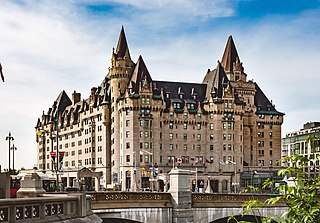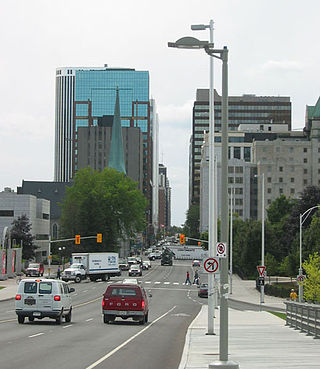
The Rideau Canal is a 202 kilometre long canal that links the Ottawa River, at Ottawa, with the Saint Lawrence River at Kingston, Ontario, Canada. Its 46 locks raise boats from the Ottawa River 83 metres upstream along the Rideau River to the Rideau Lakes, and from there drop 50 metres downstream along the Cataraqui River to Kingston.
Bytown is the former name of Ottawa, Ontario, Canada. It was founded on September 26, 1826, incorporated as a town on January 1, 1850, and superseded by the incorporation of the City of Ottawa on January 1, 1855. The founding was marked by a sod turning, and a letter from Governor General Dalhousie which authorized Lieutenant Colonel John By to divide up the town into lots. Bytown came about as a result of the construction of the Rideau Canal and grew largely due to the Ottawa River timber trade. Bytown's first mayor was John Scott, elected in 1847.

The Fairmont Château Laurier is a 660,000-square-foot (61,000 m2) hotel with 429 guest rooms in the downtown core of Ottawa, Ontario, Canada, located near the intersection of Rideau Street and Sussex Drive and designed in a French Gothic Revival Châteauesque style to complement the adjacent Parliament buildings. The hotel is above the Colonel By Valley, home of the Ottawa Locks of the Rideau Canal, and overlooks the Ottawa River. The main dining room overlooks Major's Hill Park. The reception rooms include the Wedgewood-blue Adam Room; the Laurier Room defined by Roman columns; the Empire-style ballroom and the Drawing Room featuring cream and gold plaster ornament. The hotel was designated a national historic site in 1980.

Sussex Drive, also known as Ottawa Regional Road 93, is an arterial road in Ottawa, Ontario, the capital of Canada. It is one of the city's main ceremonial and institutional routes. Travelling roughly parallel to the Ottawa River, Sussex Drive begins as a continuation of Sir George-Étienne Cartier Parkway at Rideau Gate, at the entrance to Rideau Hall. It travels south to Rideau Street, with the portion south of St. Patrick Street forming the northbound half of a one-way pair with Mackenzie Avenue. Both Mackenzie Avenue and Sussex Drive connect with Colonel By Drive at their southern end, which continues south alongside the Rideau Canal.

Lieutenant-Colonel John By was an English military engineer. He is best known for having supervised the construction of the Rideau Canal and for having founded Bytown in the process. It developed and was designated as the Canadian capital, Ottawa.

Laurier Avenue(French: Avenue Laurier) is a central east west street running through Ottawa, Ontario, Canada. Originally known as "Maria Street" and "Theodore Street", it was renamed in honour of Canadian Prime Minister Sir Wilfrid Laurier. Laurier House, the residence of Prime Ministers Laurier and William Lyon Mackenzie King, is located at the corner of Laurier Avenue East and Chapel Street.
Nicholas Sparks was an early landholder of Bytown, Upper Canada who owned most of the lands in the present day commercial core of Downtown Ottawa.

The Senate of Canada Building is a government building and former railway station that serves as the temporary seat of the Senate of Canada. Located at 2 Rideau Street in downtown Ottawa, it was known as Ottawa Union Station and served as the city's central railway station from 1912 until 1966. From 1966 to 2018, it was operated by the Government of Canada as the Government Conference Centre. The building currently includes a temporary Senate chamber, as well as some Senate offices and committee rooms.
Thomas McKay was a Canadian businessman who was one of the founders of the city of Ottawa, Ontario.

The Bytown Museum is a museum in Ottawa located in the Colonel By Valley at the Ottawa Locks of the Rideau Canal at the Ottawa River, just below Parliament Hill. Housed in the Commissariat Building, Ottawa's oldest remaining stone building, the museum provides a comprehensive overview of the origins of Bytown and its development and growth into the present city of Ottawa.
The Rideau Canal Celtic Cross is a memorial in Ottawa, Ontario, Canada, erected to commemorate the workers and their families that died building the Rideau Canal between 1826 and 1832. The granite Celtic cross has five engraved symbols: an Irish harp; a pick and shovel; a mosquito; a wheel barrow, and an explosion. It is erected close to Lock #1, in the Colonel By Valley, below Major's Hill Park and Château Laurier Hotel. The group of volunteers who erected the cross were drawn together in 2002 by the Ottawa and District Labour Council with the goal of erecting the memorial. The committee included representatives of the Workers Heritage Centre Museum and the Irish Society of the National Capital Region. The group had support from the Kingston Irish Folk Club, which has raised a number of monuments in the Kingston area. Upon the unveiling of the cross at the canal's first lock at the Ottawa River, the committee disbanded.
The Plaza Bridge in Ottawa, Ontario, Canada, is an automotive and pedestrian bridge that crosses the Rideau Canal just south of the Ottawa locks. It joins Wellington Street and Elgin Street in the Downtown core to the west with Rideau Street to the east. The Chateau Laurier abuts the bridge at the east end, while Parliament Hill is just beyond the west end. It is the northernmost bridge over the canal, just north of the Mackenzie King Bridge.
This is a timeline of the history of Ottawa.
The history of Ottawa, capital of Canada, was shaped by events such as the construction of the Rideau Canal, the lumber industry, the choice of Ottawa as the location of Canada's capital, as well as American and European influences and interactions. By 1914, Ottawa's population had surpassed 100,000 and today it is the capital of a G7 country whose metropolitan population exceeds one million.

Rideau is a station on the O-Train Confederation Line on Rideau Street on the border of the Sandy Hill and ByWard Market neighbourhoods in Central Ottawa, Ontario, Canada.

The Colonel By Valley, also known as Entrance Valley is a valley located at the confluence of the Rideau Canal and the Ottawa River, in the heart of Ottawa, Ontario, Canada. The valley is flanked on the west by Parliament Hill and on the east by the Chateau Laurier. The valley is home to a series of locks, known as the "Ottawa Locks" in the canal, as it descends into the Ottawa River. The valley is also home to the Commissariat Building, home of the Bytown Museum, the oldest stone building still standing in the city.
















